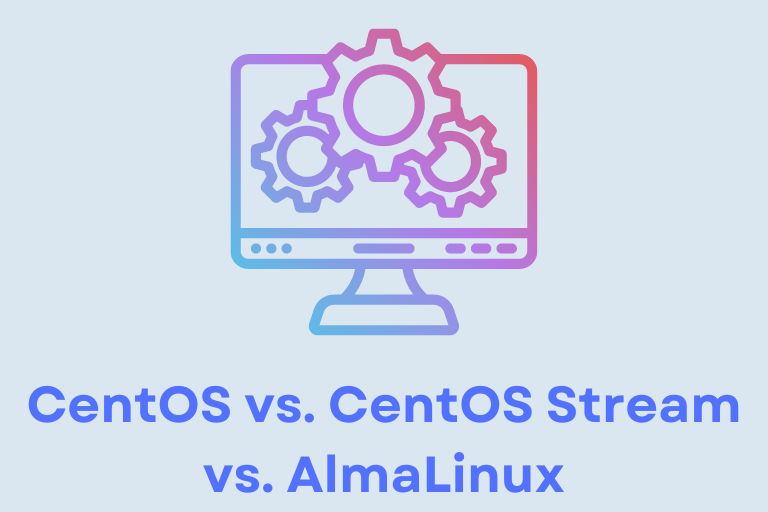The difference between CentOS vs. CentOS Stream vs. AlmaLinux may be a bit confusing, but rest assured, that will no longer be the case after this article.
Introduction
In 2019, Redhat announced that they will be changing their sponsorship for the CentOS Linux distribution. With CentOS Stream being an upstream development platform designed for CentOS community members. Then, in March 2021, CloudLinux released a new AlmaLinux distribution that is binary-compatible with Red Hat Enterprise Linux.
But wait... What is the difference between CentOS, CentOS Stream, and AlmaLinux? And what distribution should you choose? This article answers your questions.

CentOS vs. CentOS Stream vs. AlmaLinux
In summary:
- CentOS: Known for stability, but transitioning to CentOS Stream has shifted its focus towards upstream testing.
- CentOS Stream: Acts as an upstream testing ground for new software in the RHEL ecosystem, for users seeking the latest software versions.
- AlmaLinux: A 1:1 binary-compatible clone of RHEL, offering stability, reliability, and ease of use.
CentOS
CentOS was a free downstream distribution from RedHat Enterprise Linux. Redhat initially introduced updated and new software onto their Fedora operating system as a test ground. Once testing is done on Fedora, the packages then get added to RHEL for secure and robust enterprise deployments.
Once the packages are fully deployed on RHEL, they are then introduced to the free CentOS system. These heavily tested software packages that are added to CentOS make it a highly stable and reliable operating system for enterprise cloud computing and web hosting. In other words, CentOS was the free version of RHEL, which costs money.
CentOS Stream
In 2021, Red Hat Enterprise Linux announced that CentOS will be renamed as CentOS Stream, and will take a different approach. CentOS Stream will no longer be a clone of Red Hat Enterprise Linux, but instead will take a similar approach as Fedora, acting as an upstream and a testing source for RHEL. Meaning that new features will be introduced into CentOS Stream, tested heavily, and then the new updates are deployed to RHEL. This effectively gives RHEL supreme stability after its features are tested on both Fedora and CentOS Stream.
AlmaLinux
Once this news started circulating, the Linux community created new CentOS replacements like AlmaLinux and Rocky Linux to provide a free and stable production-grade enterprise version of CentOS Stream.
AlmaLinux is a production-grade enterprise operating system that is binary-compatible with Red Hat Enterprise Linux. It was initially released in March 2021 by CloudLinux to provide a community-supported spiritual successor to CentOS Linux.
So, if you are looking to upgrade your CentOS system, you may consider migrating to AlmaLinux and enjoy the same stability and reliability that CentOS was known for.
AlmaLinux is not owned by Red Hat, but it provides a compatible binary with RHEL, which makes transitioning from old CentOS installations to AlmaLinux relatively simple.
How to Get AlmaLinux

To get AlmaLinux and install it on your machine or server, check out their website for instructions on how to achieve this. Or you can just go to our website, choose the server’s specifications that fit your needs, and while prompted to choose among the operating systems and the 1-Click Applications we have, choose AlmaLinux from the dropdown menu, complete your checkout, and in a couple of minutes our algorithms will take care of all the technical aspects smoothly and effortlessly, just for you! And.. Congrats!! You can now use AlmaLinux on your server.
CentOS vs. CentOS Stream vs. AlmaLinux Overview
To summarize, here is a table outlining the key differences between CentOS, CentOS Stream, and AlmaLinux:
| CentOS | CentOS Stream | AlmaLinux | |
|---|---|---|---|
| Release Date | 14 May 2004 | 24 September 2019 | 30 March 2021 |
| Support Period | CentOS 8 support ended in 2021 | CentOS Stream 9 Expected EOL: End of RHEL9 “full support” phase (Estimated 2027) | AlmaLinux OS 9 will have active support until 31 May 2027, and security support until 31 May 2032 |
| Purpose | Was a free downstream distribution from RedHat Enterprise Linux | Replaces CentOS and acts as an upstream and a testing source for RHEL | Production-grade enterprise OS that is binary-compatible with Red Hat Enterprise Linux |
| Updates | No longer supported | Provides early access to updates | Well-tested and stable updates |
Conclusion
CentOS has been one of the most stable Linux distributions, but with its rebranding as CentOS Stream, and the emergence of AlmaLinux, things have been a bit confusing. This article clarified what CentOS is, how it differs from CentOS Stream, and how AlmaLinux is considered by many the new CentOS.



